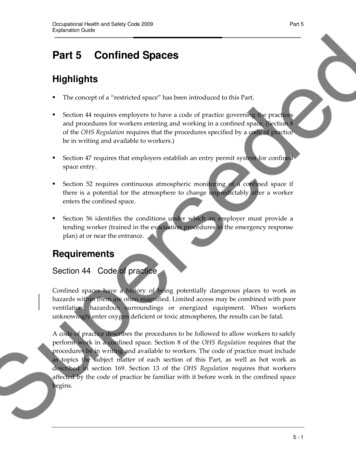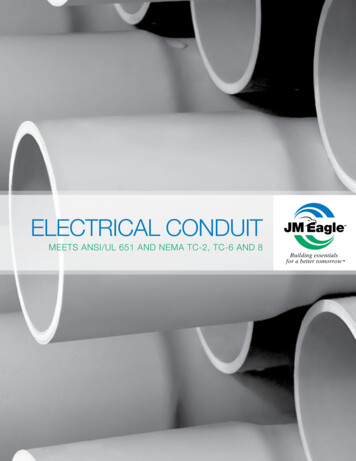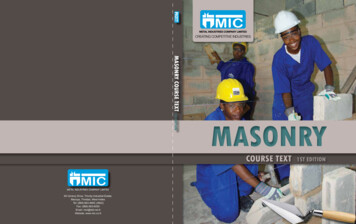
Transcription
Laying the Foundation for Space Solar Power: AnAssessment of NASA's Space Solar PowerInvestment StrategyCommittee for the Assessment of NASA's Space SolarPower Investment Strategy, Aeronautics and SpaceEngineering Board, National Research CouncilISBN: 0-309-07597-1, 94 pages, 8 1/2 x 11, (2001)This free PDF was downloaded from:http://www.nap.edu/catalog/10202.htmlVisit the National Academies Press online, the authoritative source for all books from theNational Academy of Sciences, the National Academy of Engineering, the Institute ofMedicine, and the National Research Council: Download hundreds of free books in PDF Read thousands of books online, free Sign up to be notified when new books are published Purchase printed books Purchase PDFs Explore with our innovative research toolsThank you for downloading this free PDF. If you have comments, questions or just wantmore information about the books published by the National Academies Press, you maycontact our customer service department toll-free at 888-624-8373, visit us online, orsend an email to comments@nap.edu.This free book plus thousands more books are available at http://www.nap.edu.Copyright National Academy of Sciences. Permission is granted for this material to beshared for noncommercial, educational purposes, provided that this notice appears on thereproduced materials, the Web address of the online, full authoritative version is retained,and copies are not altered. To disseminate otherwise or to republish requires writtenpermission from the National Academies Press.
Laying the Foundation for Space Solar Power: An Assessment of NASA's Space Solar Power Investment g the Foundation forSpace Solar PowerAn Assessment of NASA’sSpace Solar Power Investment StrategyCommittee for the Assessment of NASA’s SpaceSolar Power Investment StrategyAeronautics and Space Engineering BoardDivision on Engineering and Physical SciencesNational Research CouncilNATIONAL ACADEMY PRESSWashington, D.C.Copyright National Academy of Sciences. All rights reserved.
Laying the Foundation for Space Solar Power: An Assessment of NASA's Space Solar Power Investment NAL ACADEMY PRESS2101 Constitution Avenue, N.W.Washington, DC 20418NOTICE: The project that is the subject of this report was approved by the Governing Board of the NationalResearch Council, whose members are drawn from the councils of the National Academy of Sciences, theNational Academy of Engineering, and the Institute of Medicine. The members of the committee responsiblefor the report were chosen for their special competences and with regard for appropriate balance.This study was supported by Contract No. NASW-99037, Task Order 105, between the National Academy ofSciences and the National Aeronautics and Space Administration. Any opinions, findings, conclusions, orrecommendations expressed in this publication are those of the author(s) and do not necessarily reflect the viewof the organizations or agencies that provided support for the project.International Standard Book Number: 0-309-07597-1Available in limited supply from:Additional copies are available from:Aeronautics and Space Engineering BoardHA 2922101 Constitution Avenue, N.W.Washington, DC 20418(202) 334-2855National Academy PressBox 2852101 Constitution Ave., N.W.Washington, DC 20055(800) 624-6242(202) 334-3313 (in the Washingtonmetropolitan area)http://www.nas.eduCopyright 2001 by the National Academy of Sciences. All rights reserved.Printed in the United States of AmericaCopyright National Academy of Sciences. All rights reserved.
Laying the Foundation for Space Solar Power: An Assessment of NASA's Space Solar Power Investment nal Academy of SciencesNational Academy of EngineeringInstitute of MedicineNational Research CouncilThe National Academy of Sciences is a private, nonprofit, self-perpetuating society of distinguished scholarsengaged in scientific and engineering research, dedicated to the furtherance of science and technology and totheir use for the general welfare. Upon the authority of the charter granted to it by the Congress in 1863, theAcademy has a mandate that requires it to advise the federal government on scientific and technical matters.Dr. Bruce M. Alberts is president of the National Academy of Sciences.The National Academy of Engineering was established in 1964, under the charter of the National Academyof Sciences, as a parallel organization of outstanding engineers. It is autonomous in its administration and inthe selection of its members, sharing with the National Academy of Sciences the responsibility for advising thefederal government. The National Academy of Engineering also sponsors engineering programs aimed atmeeting national needs, encourages education and research, and recognizes the superior achievements of engineers. Dr. Wm. A. Wulf is president of the National Academy of Engineering.The Institute of Medicine was established in 1970 by the National Academy of Sciences to secure the servicesof eminent members of appropriate professions in the examination of policy matters pertaining to the health ofthe public. The Institute acts under the responsibility given to the National Academy of Sciences by its congressional charter to be an adviser to the federal government and, upon its own initiative, to identify issues ofmedical care, research, and education. Dr. Kenneth I. Shine is president of the Institute of Medicine.The National Research Council was organized by the National Academy of Sciences in 1916 to associate thebroad community of science and technology with the Academy’s purposes of furthering knowledge and advising the federal government. Functioning in accordance with general policies determined by the Academy, theCouncil has become the principal operating agency of both the National Academy of Sciences and the NationalAcademy of Engineering in providing services to the government, the public, and the scientific and engineering communities. The Council is administered jointly by both Academies and the Institute of Medicine. Dr.Bruce M. Alberts and Dr. Wm. A. Wulf are chairman and vice chairman, respectively, of the National ResearchCouncil.Copyright National Academy of Sciences. All rights reserved.
Laying the Foundation for Space Solar Power: An Assessment of NASA's Space Solar Power Investment TTEE FOR THE ASSESSMENT OF NASA’S SPACE SOLAR POWER INVESTMENT STRATEGYRICHARD J. SCHWARTZ, Chair, Purdue University, West Lafayette, IndianaMARY L. BOWDEN, University of Maryland, College ParkHUBERT P. DAVIS, Consultant, Canyon Lake, TexasRICHARD L. KLINE, United Satellite Launch Services, Great Falls, VirginiaMOLLY K. MACAULEY, Resources for the Future, Inc., Washington, D.C.LEE D. PETERSON, University of Colorado, BoulderKITT C. REINHARDT, Air Force Research Laboratory, Albuquerque, New MexicoR. RHOADS STEPHENSON, Jet Propulsion Laboratory (retired), La Canada, CaliforniaLiaison from the Aeronautics and Space Engineering BoardDAVA J. NEWMAN, Massachusetts Institute of Technology, CambridgeStaffKAREN E. HARWELL, Study Director, Aeronautics and Space Engineering BoardLEE SNAPP, NASA Administrator’s Fellowship Program—NRC Visiting Fellow,Aeronautics and Space Engineering BoardGEORGE M. LEVIN, Director, Aeronautics and Space Engineering BoardMARVIN WEEKS, Senior Project Assistant, Aeronautics and Space Engineering Board(May 2000 through March 2001)MARY LOU AQUILO, Senior Project Assistant, Aeronautics and Space Engineering Board(March through June 2001)ANNA FARRAR, Administrative Associate, Aeronautics and Space Engineering BoardivCopyright National Academy of Sciences. All rights reserved.
Laying the Foundation for Space Solar Power: An Assessment of NASA's Space Solar Power Investment AUTICS AND SPACE ENGINEERING BOARDWILLIAM W. HOOVER, Chair, U.S. Air Force (retired), Williamsburg, VirginiaA. DWIGHT ABBOTT, Aerospace Corporation (retired), Los Angeles, CaliforniaRUZENA K. BAJSCY, NAE, IOM, University of Pennsylvania, PhiladelphiaWILLIAM F. BALLHAUS, JR., NAE, Aerospace Corporation, Los Angeles,CaliforniaJAMES A. BLACKWELL, Lockheed Martin Corporation (retired), Marietta, GeorgiaANTHONY J. BRODERICK, aviation safety consultant, Catlett, VirginiaDONALD L. CROMER, U.S. Air Force (retired), Lompoc, CaliforniaROBERT A. DAVIS, The Boeing Company (retired), Seattle, WashingtonJOSEPH FULLER, JR., Futron Corporation, Bethesda, MarylandRICHARD GOLASZEWSKI, GRA Inc., Jenkintown, PennsylvaniaJAMES M. GUYETTE, Rolls-Royce North America, Reston, VirginiaFREDERICK H. HAUCK, AXA Space, Bethesda, MarylandJOHN L. JUNKINS, NAE, Texas A&M University, College Station, TexasJOHN K. LAUBER, Airbus Industrie of North America, Washington, D.C.GEORGE K. MUELLNER, The Boeing Company, Seal Beach, CaliforniaDAVA J. NEWMAN, Massachusetts Institute of Technology, CambridgeJAMES G. O’CONNOR, NAE, Pratt & Whitney (retired), Coventry, ConnecticutMALCOLM R. O’NEILL, Lockheed Martin Corporation, Bethesda, MarylandCYNTHIA SAMUELSON, Logistics Management Institute, McLean, VirginiaWINSTON E. SCOTT, Florida State University, TallahasseeKATHRYN C. THORNTON, University of Virginia, CharlottesvilleROBERT E. WHITEHEAD, National Aeronautics and Space Administration(retired), Henrico, North CarolinaDIANNE S. WILEY, The Boeing Company, Los Alamitos, CaliforniaTHOMAS L. WILLIAMS, Northrop Grumman, El Segundo, CaliforniaStaffGEORGE LEVIN, DirectorvCopyright National Academy of Sciences. All rights reserved.
Laying the Foundation for Space Solar Power: An Assessment of NASA's Space Solar Power Investment ight National Academy of Sciences. All rights reserved.
Laying the Foundation for Space Solar Power: An Assessment of NASA's Space Solar Power Investment ceIn 1968, Peter Glaser advanced the proposition thatsolar energy could be collected by Earth-orbiting satellites and then beamed by means of microwaves topower stations on Earth’s surface. The energy collectedwould be converted to electricity and introduced intocommercial power grids for use by customers. Boththe Department of Energy and the National Aeronautics and Space Administration (NASA) examined theconcept in the late 1970s and early 1980s; however, theprogram was canceled. In 1995, NASA decided to takea fresh look at the feasibility, technologies, costs, markets, and international public attitudes regarding spacesolar power (SSP). This Fresh Look study1 found thatmuch had changed. Key technologies needed for theconstruction, deployment, and maintenance of SSP satellites, such as composite materials, modular fabrication, and robotics for construction and repair, had allshown significant advances. During this period, publicconcerns about environmental degradation grew. Thecommittee also noted that such environmental concernsare, if anything, even more intense today than in thedays of the Fresh Look study. As a result of this study,the U.S. Congress became interested in SSP and in FY1999 appropriated funds for NASA to conduct the SSPExploratory Research and Technology (SERT) program. The SERT program and its follow-on, the SSPResearch and Technology (SSP R&T) program, constitute the effort assessed in this report.2In March 2000, NASA’s Office of Space Flightasked the Aeronautics and Space Engineering Board ofthe National Research Council to perform an independent assessment of the space solar power program’stechnology investment strategy to determine its technical soundness and its contribution to the roadmap thatNASA has developed for this program.3 The program’sinvestment strategy was to be evaluated in the context2The SERT program was established in FY 1999 and continued throughFY 2000 by U.S. congressional appropriation. An additional appropriationwas also funded for SSP Research and Technology (SSP R&T) for FY2001. Decisions on internal NASA budget allocations for FY 2002 werepending during the preparation and review of this report. As a result ofrecent agencywide realignments, future SSP programs may be includedwithin other NASA initiatives. Throughout this report the term “SERTprogram” or “SERT effort” refers to both the 2-year Space Solar PowerExploratory Research and Technology (SERT) program during FY 1999and 2000 and the follow-on effort in FY 2001, referred to as the SSP Research and Technology (SSP R&T) program. The terms “SSP program”and “SSP effort” refer to any planned future program in SSP technologydevelopment and are used in recommendations to NASA.3This assessment evaluates the SERT program and the follow-on SSPR&T efforts through December 15, 2000. Program changes after that dateare not included.1Feingold, Harvey, Michael Stancati, Alan Freidlander, Mark Jacobs,Doug Comstock, Carissa Christensen, Gregg Maryniak, Scott Rix, and JohnMankins. 1997. Space Solar Power: A Fresh Look at the Feasibility ofGenerating Solar Power in Space for Use on Earth. Report No. SAIC-97/1005. Chicago, Ill.: Science Applications International Corporation (SAIC).viiCopyright National Academy of Sciences. All rights reserved.
Laying the Foundation for Space Solar Power: An Assessment of NASA's Space Solar Power Investment REFACEof its likely effectiveness in meeting the program’stechnical and economic objectives. The scope of thisstudy did not include assessments of the desirability ofspace-generated terrestrial electrical power or assessment of the ability of NASA’s space launch development efforts to provide the capability needed to deploya space solar power system.The Committee for the Assessment of NASA’sSpace Solar Power Investment Strategy of the NationalResearch Council has completed an approximately 12month study evaluating the technology investmentstrategy of NASA for SSP. A copy of the statement oftask for this study is included in Appendix A. In conducting its review, the committee was not asked to assess, and it did not comment on, the ultimate economicviability of producing terrestrial solar power fromspace. The committee sees the wisdom of investingsome of this nation’s resources in a number of potentialapproaches for dealing with future energy needs. Thisis particularly true when the committee considers thepotential payoffs from this investment to other NASA,government, and commercial programs. This reportprovides an assessment of NASA’s management of itsSSP investments and provides recommendations onhow its technical investment process can be improved.The committee recognized that NASA deliberatelyexcluded “lowering the cost of access to space” (i.e.,development of new Earth-to-low-Earth-orbit launchvehicles) in its roadmap for SSP technology development. The committee understands and accepts NASA’srationale for this decision. NASA has a major programdevoted to lowering the cost of access to space. Giventhe relatively small amount of funding earmarked byCongress for space solar power technology development, little could be accomplished (and much would belost) by using these program resources to help lowerthe cost of access to space.This study was sponsored by NASA and conductedby a committee appointed by the National ResearchCouncil (see Appendix B). The statement of task directed the committee to (1) evaluate NASA’s SSP efforts and (2) provide an assessment of its particularinvestment strategy for a potential program in SSPtechnology research and development. In order to effectively prioritize and balance investments across several technology areas, rigorous modeling and systemanalysis studies are usually performed. NASA beganthis process during the SERT effort. Preliminary technology and programmatic investments were presentedto the committee based on this modeling and seem re-alistic, taking into account the level of funding madeavailable to the program. The committee believes thatthis approach is one useful technique for assigningtechnology investment priorities and determining therelative payoff from technology investments. The committee discovered during its meetings, however, thatmany of the modeling inputs were suspect and thatmore refinement and better validation were necessarybefore additional decisions were made regarding technology investment balance. Consequently, the committee agreed that it would be inappropriate to evaluate theactual magnitude of funding in each technical area.Comments on the relative amounts for various technologies are included.As a result of low overall program funds during thepast 3 years, the program has been forced to make muchsmaller investments than desired for research in various technical areas. Due to this mismatch between theactual funding and program plan, the committee believed it was critical to evaluate the organizationalfoundations, modeling methodologies, and programmanagement style on which the future SSP investmentstrategy will be based (despite levels of funding available to the program). These issues led the committee toperform a two-part assessment of the program, providing (1) an evaluation of the total program investmentstrategy, management, and organization and (2) anevaluation of each individual SSP-related technologyarea. The structure of the following report is based onthese two factors.The committee was not asked to evaluate technology development in SSP-related areas in the UnitedStates or worldwide or to evaluate any other NASA ornon-NASA programs in technology development,whether related to SSP or not. As a result, no othertechnology program structure was assessed or mentioned in the report. However, knowledge of the stateof the art in various technical areas is necessary to effectively evaluate any research and technology effort.Various options for generating power from space havebeen suggested (and researched) during the past 30years, including the Lunar Solar Satellite Concept proposed by David Criswell, among others. The committee did not consider such competing concepts for solarpower from space but concentrated solely on the NASASERT program. To this extent, the committee has focused on the program at NASA and its relationship withindustry and other efforts in SSP-related technology.This report has been reviewed in draft form by individuals chosen for their diverse perspectives and tech-Copyright National Academy of Sciences. All rights reserved.
Laying the Foundation for Space Solar Power: An Assessment of NASA's Space Solar Power Investment FACEnical expertise, in accordance with procedures approved by the National Research Council’s (NRC’s)Report Review Committee. The purpose of this independent review is to provide candid and critical comments that will assist the institution in making its published report as sound as possible and to ensure that thereport meets institutional standards for objectivity, evidence, and responsiveness to the study charge. Thereview comments and draft manuscript remain confidential to protect the integrity of the deliberative process. We wish to thank the following individuals fortheir review of this report:Minoru S. Araki, Lockheed Martin Corporation,retired,Richard Green, International Power and Environmental Company,Joel Greenberg, Princeton Synergetics, Inc.,Nasser Karam, Spectralab, Inc.,Thomas J. Kelly, Grumman Corporation, retired,Leeka I. Kheifets, Electric Power Research Institute(EPRI),Mark S. Lake, Composite Technology Development, Inc.,F. Robert Naka, CERA, Inc., andStephen M. Rock, Stanford University.Although the reviewers listed above have providedmany constructive comments and suggestions, theywere not asked to endorse the conclusions or recommendations, nor did they see the final draft of the report before its release. The review of this report wasoverseen by Gerald L. Kulcinski, University of Wisconsin, appointed by the NRC’s Report Review Committee, who was responsible for making certain that anindependent examination of this report was carried outin accordance with institutional procedures and that allreview comments were carefully considered. Responsibility for the final content of this report rests entirelywith the authoring committee and the institution.The committee also thanks those who took the timeto participate in committee meetings and provide background materials (see Appendix E). The committee isespecially indebted to Karen Harwell, study director,for her unflagging support of the committee and herhelp every step of the way. Lee Snapp, a NASAAdministrator’s Fellowship Program visiting fellow,contributed to the introduction and international sections of the report, and George Levin, director, Aeronautics and Space Engineering Board, was particularlyhelpful in interpreting and clarifying the committee’scharge.Richard J. Schwartz, ChairCommittee for the Assessment of NASA’sSpace Solar Power Investment StrategyCopyright National Academy of Sciences. All rights reserved.
Laying the Foundation for Space Solar Power: An Assessment of NASA's Space Solar Power Investment ight National Academy of Sciences. All rights reserved.
Laying the Foundation for Space Solar Power: An Assessment of NASA's Space Solar Power Investment ntsEXECUTIVE SUMMARY11 INTRODUCTION1-1 Electricity and Solar Power, 91-2 Background, 101-3 Study Approach, 11References, 1192 OVERALL SERT PROGRAM EVALUATION2-1 Evaluation of Total Program Plan and Investment Strategy, 122-2 Applications, 232-3 International Efforts, 25References, 27123 INDIVIDUAL TECHNOLOGY INVESTMENT EVALUATIONS3-1 Systems Integration, 293-2 Solar Power Generation, 343-3 Space Power Management and Distribution, 373-4 Wireless Power Transmission, 403-5 Ground Power Management and Distribution, 423-6 Space Assembly, Maintenance, and Servicing, 433-7 Structures, Materials, and Controls, 473-8 Thermal Materials and Management, 513-9 Space Transportation and Infrastructure, 533-10 Environmental, Health, and Safety Factors, 563-11 Platform Systems, 60References, 6029xiCopyright National Academy of Sciences. All rights reserved.
Laying the Foundation for Space Solar Power: An Assessment of NASA's Space Solar Power Investment NTENTSAPPENDIXESABCDEFStatement of TaskBiographical Sketches of Committee MembersExample of NASA’s SERT Program Technology RoadmapsBrief Overview of NASA’s Space Solar Power ProgramParticipants in Committee MeetingsAcronyms and AbbreviationsCopyright National Academy of Sciences. All rights reserved.656669737779
Laying the Foundation for Space Solar Power: An Assessment of NASA's Space Solar Power Investment s and FiguresTABLESES-1Proposed Space Solar Power Program Resources Allocation,FY 2002 to FY 2006, 22-12-2NASA’s SERT Program—Model System Category Definitions, 13Proposed Space Solar Power Program Resources Allocation,FY 2002 to FY 2006, 17D-1Proposed Space Solar Power Program Resources Allocation,FY 2000 to FY 2016, 76FIGURESES-1Key recommendations to the NASA SSP program, 32-12-2NASA’s SERT program: research and technology schedule of milestonesroadmap, 14NASA’s SERT program: strategic research and technology goals, 163-1NASA’s SERT program integration process, 30C-1C-2C-3Sample SERT progam executive summary chart on solar power generationactivity, 70Sample SERT program goal chart on solar power generation activity, 71Sample SERT program milestones chart on solar power generation activity, 72D-1D-2Generic space solar power system, 74Generic microwave and laser SSP systems, 74xiiiCopyright National Academy of Sciences. All rights reserved.
Laying the Foundation for Space Solar Power: An Assessment of NASA's Space Solar Power Investment ight National Academy of Sciences. All rights reserved.
Laying the Foundation for Space Solar Power: An Assessment of NASA's Space Solar Power Investment tive SummaryNASA’S SPACE SOLAR POWER EXPLORATORYRESEARCH AND TECHNOLOGY (SERT)PROGRAMNASA focused the SERT effort3 by utilizing thedefinition of a “strawman” or baseline SSP system thatwould provide 10 to 100 GW to the ground electricalpower grid with a series of 1.2-GW satellites in geosynchronous Earth orbit (GEO). For each of the majorSSP subsystems, NASA managers developed top-levelcost targets in cents per kilowatt-hour (kW-hr) that theyfelt would have to be met to deliver baseload power ata target of 5 cents/kW-hr. The result of this work wasa set of time-phased plans with associated cost estimates that provided the basis for a technology investment strategy. Central to the SERT program was aseries of five or six experimental flight demonstrationsof progressively larger power-generation capacity,called Model System Categories. These demonstrationswill serve as focal points for the advancement of SSPrelated technologies and will provide advancements intechnologies benefiting other nearer-term military,space, and commercial applications. NASA made extensive use of cost and performance modeling to guideits technology investment strategy.The National Aeronautics and Space Administration’s Space Solar Power (SSP) Exploratory Research and Technology (SERT) program1 was chargedto develop technologies needed to provide cost-competitive ground baseload electrical power2 from spacebased solar energy converters. In addition, during its 2year tenure, the SERT program was also expected toprovide a roadmap of research and technology investment to enhance other space, military, and commercialapplications such as satellites operating with improvedpower supplies, free-flying technology platforms,space propulsion technology, and techniques for planetary surface exploration.1The SERT program was established in FY 1999 and continuedthrough FY 2000 by U.S. congressional appropriation. An additional appropriation was also funded for SSP Research and Technology (SSP R&T) for FY 2001. Decisions on internal NASAbudget allocations for FY 2002 were pending during review andpublication of this report. During recent agencywide realignments,future SSP programs may be included within other NASA initiatives.2Baseload power is defined as the power available to an area ata constant level during a 24-hour period. For example, most of thepower available to residential and business areas is consideredbaseload power.3Throughout this report the terms “SERT program” and “SERTeffort” refer to both the 2-year Space Solar Power Exploratory Research and Technology (SERT) program during FY 1999 and 2000and the follow-on effort in FY 2001, the SSP Research and Technology (SSP R&T) program. The terms “SSP program” and “SSPeffort” refer to any planned future program in SSP technology development.1Copyright National Academy of Sciences. All rights reserved.
Laying the Foundation for Space Solar Power: An Assessment of NASA's Space Solar Power Investment NG THE FOUNDATION FOR SPACE SOLAR POWERCOMMITTEE ASSESSMENTThe current SSP technology program4 is directedat technical areas that have important commercial,civil, and military applications for the nation. A dedicated NASA team, operating with a minimal budget,has defined a potentially valuable program—one thatwill require significantly higher funding levels andprogrammatic stability to attain the aggressive performance, mass, and cost goals that are required for terrestrial baseload power generation. Nevertheless, significant breakthroughs will be required to achieve thefinal goal of cost-competitive terrestrial baseloadpower. The ultimate success of the terrestrial powerapplication depends critically on dramatic reductionsin the cost of transportation from Earth to GEO. Funding plans developed during SERT are reasonable, atleast during the 5 years prior to the first flight demonstration in 2006 (see Table ES-1). The committee isconcerned, however, that the investment strategy maybe based on modeling efforts and individual cost, mass,and technology performance goals that may guide management toward poor investment decisions. Modelingefforts should be strengthened and goals subjected toadditional peer review before further investment decisions are made. Furthermore, SERT goals could be accomplished sooner and potentially at less cost throughan aggressive effort by the SERT program to capitalizeon technology advances made by organizations outsideNASA.COMMITTEE RECOMMENDATIONSRecommendations to the NASA SSP program canbe generally categorized by three main imperatives: (1)improving technical management processes, (2) sharpening the technology development focus, and (3) capitalizing on other work. Figure ES-1 provides a snapshot of the committee’s key recommendations. Eachrecommendation is numbered to correspond to the textsection in which it is discussed.Improving Technical Management ProcessesNASA’s SERT program’s technical managementprocesses need to be improved. Currently the program4This assessment evaluates the SERT program and the followon SSP R&T efforts through December 15, 2000. Program changesafter that date are not included.TABLE ES-1 Proposed Space Solar Power ProgramResources Allocation, FY 2002 to FY 2006 (millionsof dollars)InvestmentAreaSystems integration,analysis, and modelingTotal technologydevelopmentTechnology flightdemonstrationsTotal 2814915410882512475211125282150312SOURCE: Adapted in part from “Strategic Research and Technology Road Map.” Briefing by John Mankins and Joe Ho
Download hundreds of free books in PDF Read thousands of books online, free Sign up to be notified when new books are published Purchase printed books . Space Solar Power: A Fresh Look at the Feasibility of Generating










